How to Buy Diamonds – A Luxury Guide for Selecting the Very Finest Quality
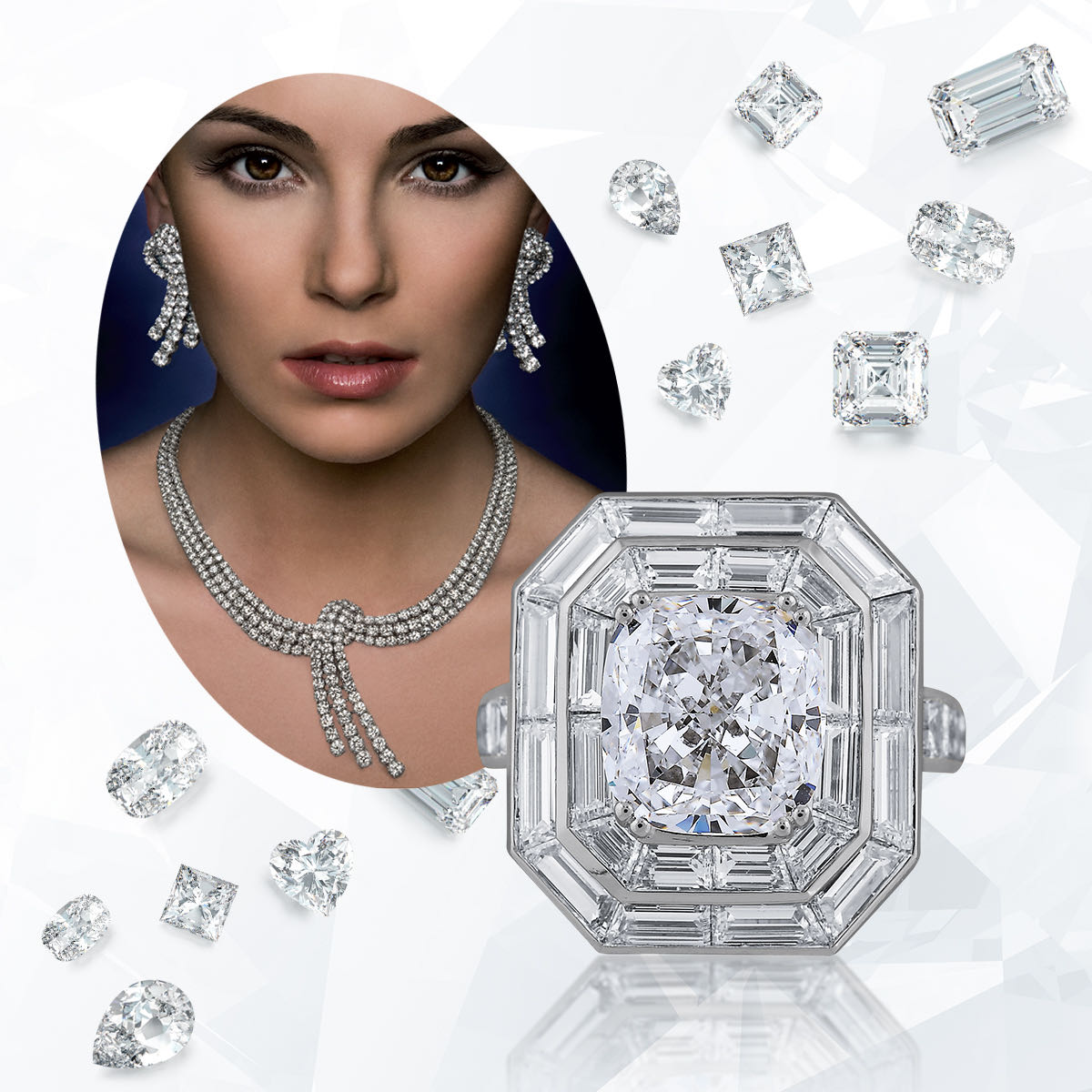
“A diamond may be forever, as the saying goes, but not all diamonds are created equal,” says Giuseppe Picchiotti, internationally renowned gem expert and founder of the PICCHIOTTI jewelry brand. “One of the most delightful things about diamonds is that they can be as unique as snowflakes, each with its own distinctive radiance and sparkle. This is both a blessing and a bane, creating specific challenges when shopping for a diamond.”
Over the years, having traveled around the world in search of the very highest quality diamonds and gemstones, Giuseppe has developed his own criteria for selecting the very finest quality of diamonds. While there are many diamond buying guides out there, here we will look at the PICCHIOTTI way of buying diamonds, to help luxury shoppers ensure that they are buying the best.
The 4 Cs – Understanding the Basics
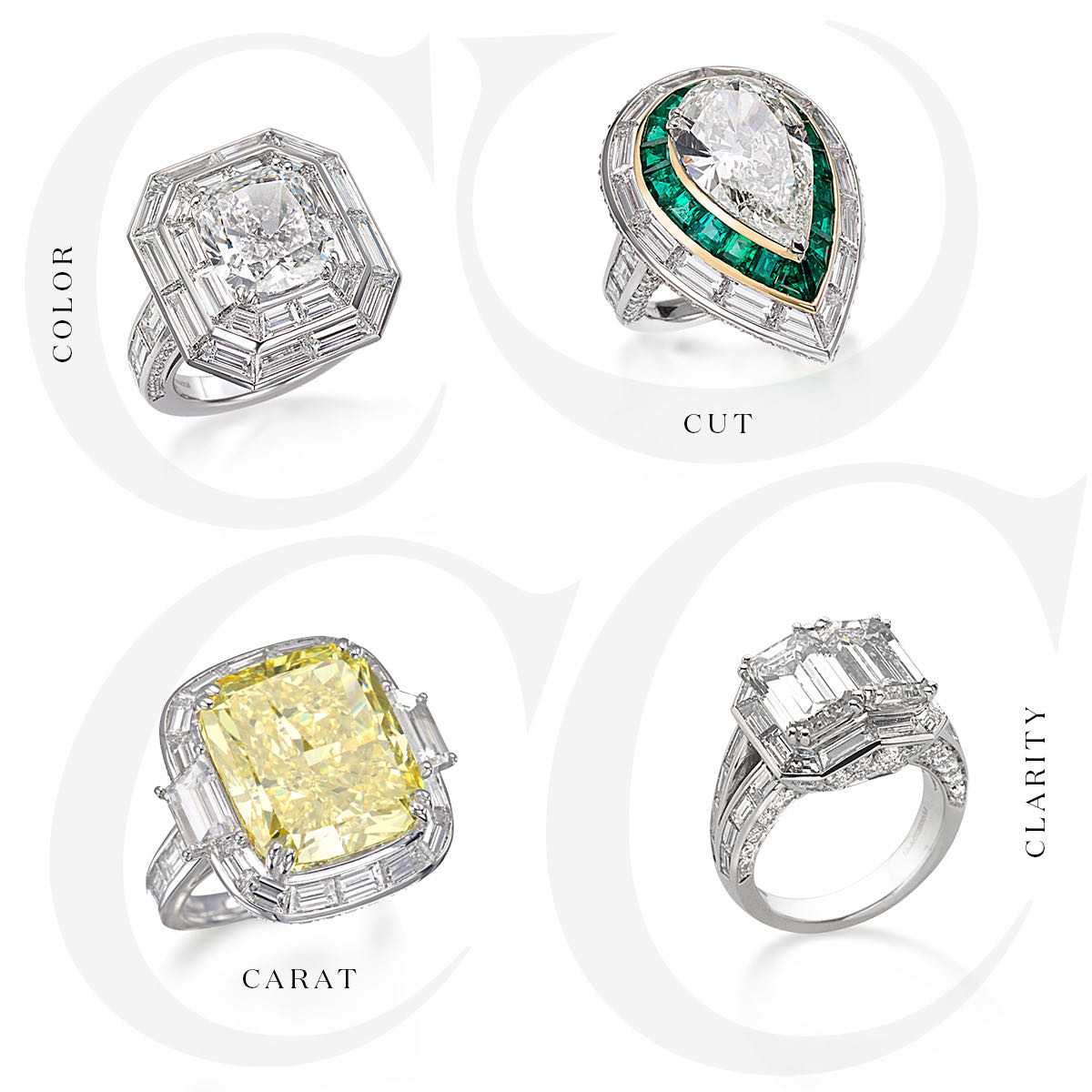
Clockwise from Upper Right – PICCHIOTTI Diamond Masterpiece Ring (RF08) featuring a 5.26 ct. F Color Cushion Cut Diamond center surrounded by Baguette Diamonds, PICCHIOTTI Masterpieces Diamond Ring (RD32) featuring an “Excellent” Pear Cut Diamond center, PICCHIOTTI Masterpieces Diamond Ring (R916) featuring matching Emerald Cut Diamonds with High Clarity Scores (VVS1 and VS1), PICCHIOTTI Masterpiece Fancy Yellow Diamond Ring (RD80) featuring one of the largest diamonds the Picchiotti family has ever sold, weighing 20.62 Carats.
COLOR – For Mr. Picchiotti (and for all diamond afficionados), the less color he finds in a diamond, the better. Diamonds with less color have higher color grades. According to the GIA (Gemological Institute of America), “the less color in a diamond, the more desirable and valuable it is. Some of these differences are not visible to the naked eye, but directly impact the overall quality and price of the stone.” Experts use highly technical equipment, special lighting, and high-powered microscopes when evaluating loose diamonds. Diamond Color is graded on an alphabetical scale, with D being the highest score, meaning absolutely colorless, and L-Z being the lowest scores, meaning the most amount of visible color. PICCHIOTTI typically buys diamonds with a minimum color grade range of F or G to ensure the brightest sparkle and “whitest” or most colorless diamonds. In the image above, note the beautiful, translucent white color in the center Cushion-Cut Diamond in ring (RF08) upper right – the stone was graded as an F color on the GIA lab report.
CLARITY – Diamond Clarity is a measure of cleanliness. The GIA states that Diamond Clarity “measures the amount, size and placement of internal ‘inclusions,’ and external ‘blemishes.’ Grades run from ‘Flawless,’ with virtually no imperfections, to ‘Included,’ which contain a significant number of imperfections.” The fewer inclusions or blemishes in a diamond, the purer the stone and consequently the higher the clarity grade. Clarity grades uses acronyms to reflect their meaning. For example, “IF” indicates Internally Flawless; “VVS” indicates Very Very Slightly included, “VS” indicates Very Slightly included; “SI” indicates Slightly Included meaning that the diamond may have slight inclusions; “I1” indicates Included meaning the diamond has inclusions; “I2” indicates that the diamond has more inclusions and so on. Within these denominations, there are further distinctions – for example “VS1” indicates very slight inclusions that are quite difficult to see, even under the high powered 10X magnification microscopes that gem experts use to discern these scores. “VS2” indicates very slight inclusions that are somewhat easy to see, only under the microscope. PICCHIOTTI typically buys diamonds that are a minimum of VS1 and VS2 so that no natural inclusions or blemishes will be visible to the human eye. In the image above, note the ring in the bottom right (R916) – it boasts two twin emerald-cut diamonds, one is VVS1 and the other is VS1.
CUT – Diamond Cut, contrary to popular belief, does not refer to the shape of the diamond. Instead, according to the GIA, the cut score reflects “the proportion and arrangement of a diamond’s facets and the quality of workmanship. The amount of brilliance, sparkle, and fire in a diamond is determined by cut.” There are several parameters that determine the quality of a good cut, including light performance, symmetry, and polish. For assessing this particular score, a trained eye is essential, as well as expertise in the parameters themselves. Grades for Diamond Cut range from Excellent to Very Good to Good to Poor. The Picchiotti family always seeks diamonds with exceptional cut scores to ensure that the stone will sparkle properly in their fine jewelry designs. According to Giuseppe, at the end of the day, a well-proportioned cut should always enhance the qualities of the natural stone. The Pear-Cut Diamond in the center of the ring in the upper right of the above image (RD32) scored particularly highly on the diamond grading report for Cut. Note how this shape and the precision of the cut amplifies the sparkle of that particular diamond.
CARAT WEIGHT – Carat weight is the one C that people are most familiar with. It measures the size of the diamond (its literal weight). Generally speaking, with a higher carat weight (all other parameters being equal) the price of a diamond will be higher, but we cannot forget that the price of a diamond is determined by all 4C’s. It is possible for smaller diamonds to have higher prices than larger ones, if the quality factors of the smaller stones are greater. For example, a flawless 1 carat diamond will cost more than a Slightly Included (SI) larger diamond of 1.25 carats. Rarity is also a factor. The rarer a precious gem is, the higher its price. Flawless, Colorless, Perfectly Cut diamonds will be more expensive, even if they are smaller. The impressive 20.62 carat Fancy Yellow Diamond shown above (bottom left of image) is one of the largest diamonds PICCHIOTTI has ever sold.
The Fifth C – Character
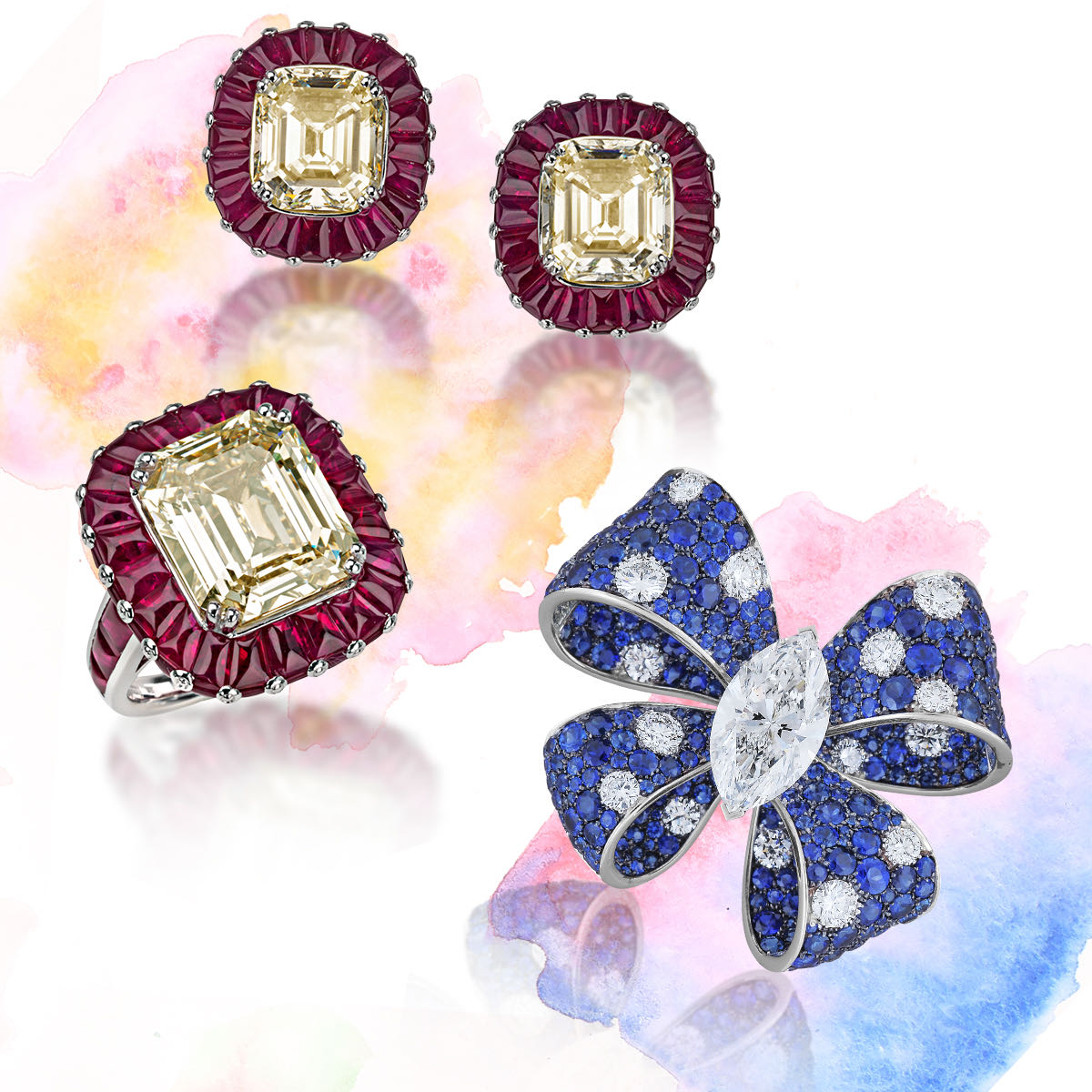
Clockwise from Upper Right – PICCHIOTTI Masterpieces Diamond and Buff-Top Ruby Earrings, PICCHIOTTI Fiocco (Bow) Ring in Sapphires and Diamonds, PICCHIOTTI Masterpieces Diamond and Buff-Top Ruby Ring
Giuseppe says that buying a diamond is also a matter of feeling. Each diamond has its own unique character. “I listen when the Diamond speaks to me,” says Giuseppe. “Sometimes unique diamonds appeal to me because they are different or outside the norm.” For example, sometimes the Picchiottis will come across good diamonds whose color may not be so high, so they will have lower color grades than what is normally acceptable for the brand. However, if the stones are well cut, with good proportion, and important carat weights, these factors can all contribute to the stones showing nicely in a particular piece of jewelry. With creativity and a refined sense of design, such unique diamonds can create gorgeous masterpieces. Take for example the Stunning Studs Earrings and the matching ring where the warmth of color in the emerald-cut diamonds are beautifully enhanced by the surrounding rubies. PICCHIOTTI’s signature style of architecturally inspired silhouettes is achieved with an extensive frame of re-cut, precisely calibrated, buff-top baguette rubies. The rare, large size of the diamonds also contributes to making these two important pieces of incredible fine jewelry.
Another aspect that gives diamonds a unique character is shape. While certain shapes tend to trend from year to year (round, oval, emerald-cut, etc.), sometimes unique or fancy shapes can be appealing. They may be less coveted for one pop culture reason or another, but certain shapes lend themselves to certain types of design. The marquis diamond in the middle of this gorgeous Sapphire Fiocco (Bow) ring is the perfect “knot” or center of the bow.
Diamond Grading – Always Ask to See the Diamond Grading Report
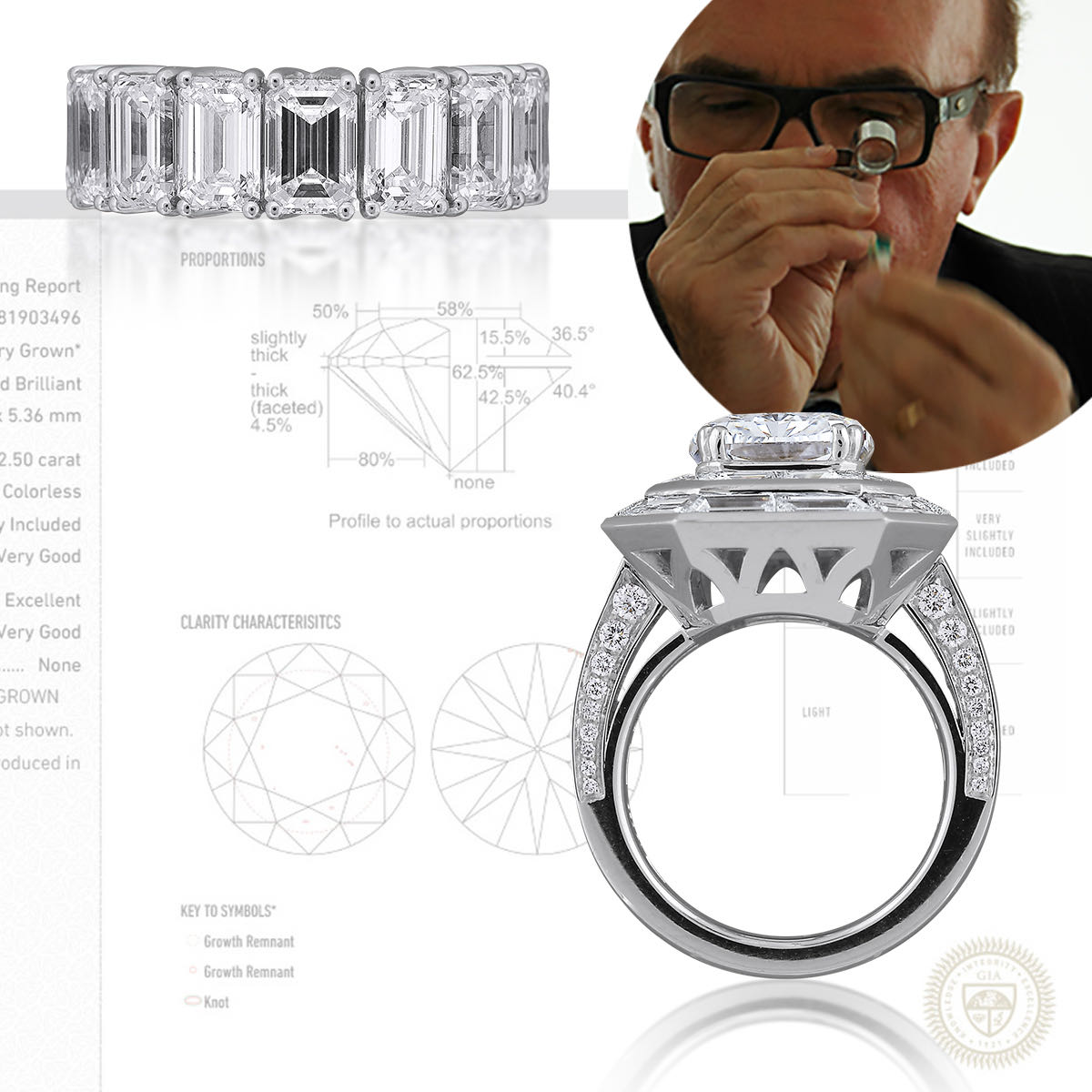
Clockwise from Upper Right – Xpandable™ Ring (RH32) in Platinum with Emerald Cut Diamonds, Mr. Giuseppe Picchiotti inspecting a ring with a jeweler’s loupe, Side View of PICCHIOTTI Masterpieces Diamond Ring RF08
When shopping for a diamond, it is crucial to review the diamond grading report. Always ask to see it and work with trained and trusted professionals who can help you understand what the report is telling you. Each of the 4 C’s referenced above will have a grade on the report. Check the scores and compare them to the PICCHIOTTI minimum standards (Color between D-G grades, Clarity of VS2 or better, Cut scores of Very Good to Excellent). As you examine the particular diamond, looking at it with a jeweler’s loupe, be sure to look at it in various lights. Natural lighting is best, but highly impractical. A handheld light source such as a flashlight or the flashlight feature on your mobile phone can help to get different views and reflections of light in the stone.
For any and all stones above a half carat (0.50 ct.) in size, the Picchiottis will only buy the diamond if it is accompanied by a diamond grading report from either the GIA or HRD (the Diamond High Council in Antwerp, the European counterpart of the GIA). If the stone has no grading report, and it appears to be worth it, Giuseppe will send the stone to the GIA laboratory to have it certified.
Matching – Pairing Comparable Stones Requires Diligence
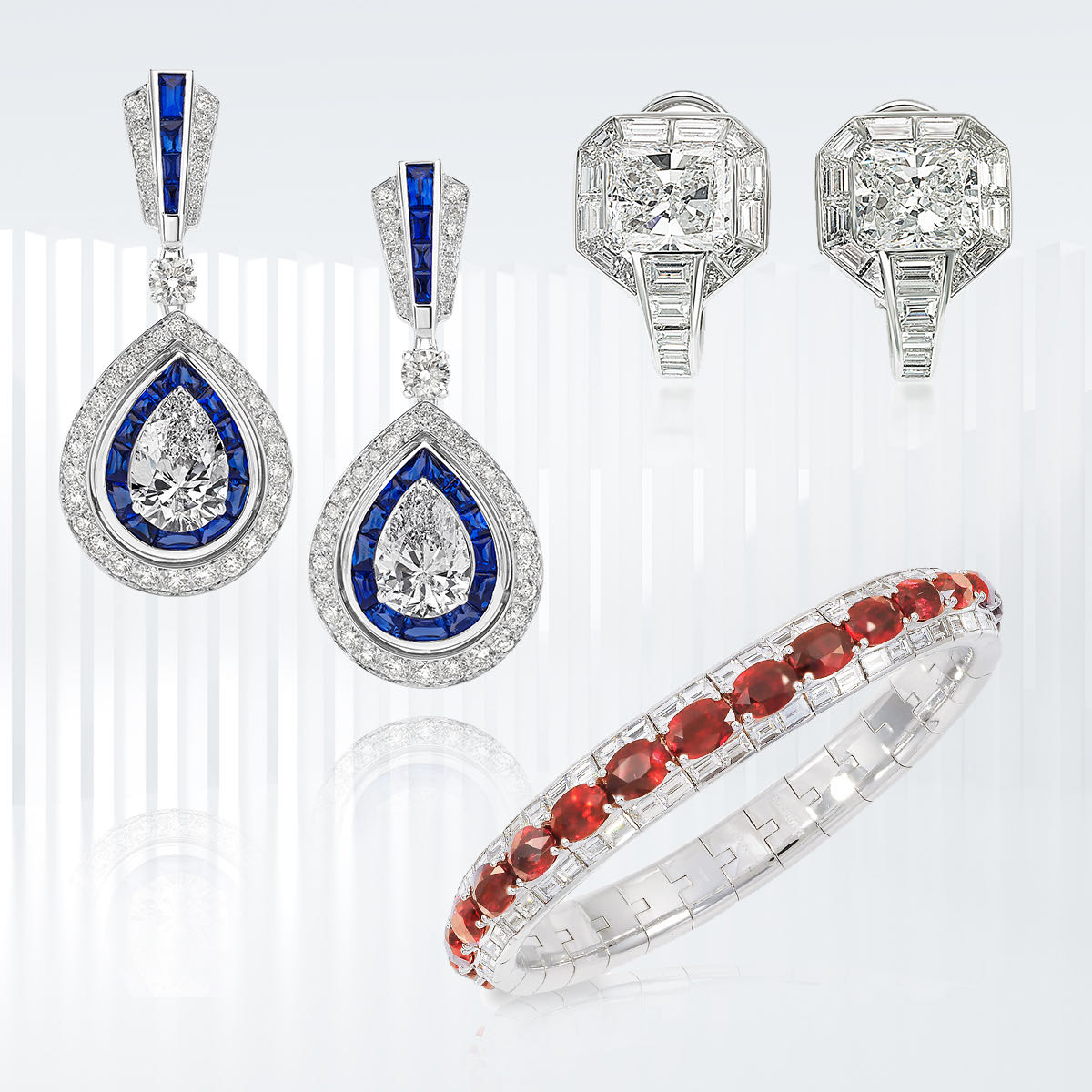
Clockwise from Upper Right – PICCHIOTTI Diamond Earrings with Matching Emerald Cut Diamonds surrounded by Baguettes, Xpandable™ Pigeon’s Blood Ruby and Baguette Diamond Bracelet, PICCHIOTTI Drop Earrings featuring two matching Pear Shape Diamonds and perfectly recut Buff Top Sapphires
Another significant element for PICCHIOTTI when it comes to selecting the finest diamonds is matching. Obviously, earring pairs will need to have matching diamonds. But also, most of the jewelry designed by PICCHIOTTI incorporates more than one diamond. It is critical to compare the diamond grading reports for similarities in quality when making a purchase of more than one diamond. Compare the grading reports line by line for similarities in scores amongst the four Cs. Also, be sure to look at the diamond with a jeweler’s loupe if you have access. The gem cutters and polishers in the PICCHIOTTI factory use high powered microscopes which can also be used to examine the similarities and differences of matching stones.
Sometimes the Picchiotti family will collect certain stones and save them over the years until they can be put together in one design. For example, this platinum Xpandable™ Bridal band is very unique, as it bears 16 emerald-cut diamonds, each one at least one carat, and all with very high scores in color and clarity. Each diamond in the ring has its own GIA diamond grading report. These stones were collected over a period of several years. Once the design concept was agreed upon, the Picchiotti family had to search for the stones one by one. This ring also required a significant investment because some of the stones had to be precisely trimmed to perfectly match the others in the band, without losing any sparkle or light performance. The result was well worth the investment because this ring is now a unique piece of jewelry that will last forever. Such a fete of engineering and design is only possible because the Picchiottis are true connoisseurs with the right connections, knowledge, and experience to make it happen.
Also, superlative colored gemstones call for exceptional diamonds. For example, the Xpandable™ bracelet shown above features an incredibly important and impressive layout of authentic Pigeon’s Blood Rubies – some of the finest quality rubies known to man. With such remarkable rubies, only the very highest quality of baguette diamonds can be used as accent stones.
When shopping for a diamond, the wisest choice is always to work with a trusted professional in a reputable fine jewelry store. Always ask to view the diamond grading report and carefully consider each of the 4 C’s. Lastly, always try it on. No matter how beautiful a diamond piece of jewelry may be in a case, it is infinitely more beautiful when worn. If you are shopping for someone else, ask a sales representative to try it on for you. Be sure to view the piece in different light sources, and if you have access to a jeweler’s loupe, use it. It is genuinely exciting to see the marvel of Mother Nature’s brilliance by viewing a diamond up close. That diamond that took thousands of years to form will last beyond your lifetime. So, shop wisely and treasure your diamonds forever. Store them safely, get them cleaned periodically, and WEAR them to bring smiles to the faces of the people around you.
Feature image at top – Clockwise from Upper Right – Model wearing PICCHIOTTI knot necklace and matching earrings in large diamonds falling in a mesmerizing cascade, various loose diamonds of different shapes, PICCHIOTTI Diamond Masterpiece ring
If you liked this, you might also like…
How to Buy Rubies – A Luxury Buying Guide for Selecting the Very Finest Quality
How to Buy Sapphires – A Luxury Buying Guide for Selecting the Very Finest Quality
Masterpieces Necklaces – Behind the Scenes Stories of One-of-a-Kind Jewels and Statement Styles


